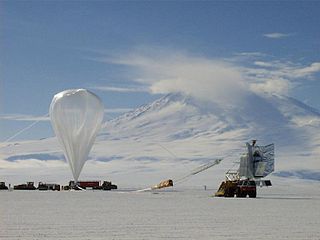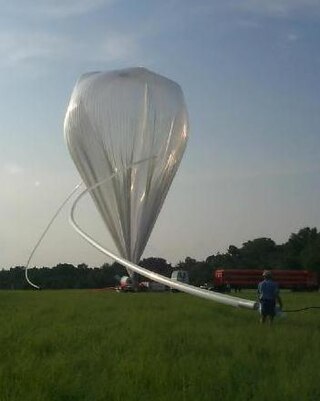Related Research Articles

Anisotropy is the structural property of non-uniformity in different directions, as opposed to isotropy. An anisotropic object or pattern has properties that differ according to direction of measurement. For example, many materials exhibit very different physical or mechanical properties when measured along different axes, e.g. absorbance, refractive index, conductivity, and tensile strength.

The cosmic microwave background, or relic radiation, is microwave radiation that fills all space in the observable universe. With a standard optical telescope, the background space between stars and galaxies is almost completely dark. However, a sufficiently sensitive radio telescope detects a faint background glow that is almost uniform and is not associated with any star, galaxy, or other object. This glow is strongest in the microwave region of the electromagnetic spectrum. The accidental discovery of the CMB in 1965 by American radio astronomers Arno Penzias and Robert Wilson was the culmination of work initiated in the 1940s.

The Wilkinson Microwave Anisotropy Probe (WMAP), originally known as the Microwave Anisotropy Probe, was a NASA spacecraft operating from 2001 to 2010 which measured temperature differences across the sky in the cosmic microwave background (CMB) – the radiant heat remaining from the Big Bang. Headed by Professor Charles L. Bennett of Johns Hopkins University, the mission was developed in a joint partnership between the NASA Goddard Space Flight Center and Princeton University. The WMAP spacecraft was launched on 30 June 2001 from Florida. The WMAP mission succeeded the COBE space mission and was the second medium-class (MIDEX) spacecraft in the NASA Explorer program. In 2003, MAP was renamed WMAP in honor of cosmologist David Todd Wilkinson (1935–2002), who had been a member of the mission's science team. After nine years of operations, WMAP was switched off in 2010, following the launch of the more advanced Planck spacecraft by European Space Agency (ESA) in 2009.

The Cosmic Background Explorer, also referred to as Explorer 66, was a NASA satellite dedicated to cosmology, which operated from 1989 to 1993. Its goals were to investigate the cosmic microwave background radiation of the universe and provide measurements that would help shape our understanding of the cosmos.

Observational cosmology is the study of the structure, the evolution and the origin of the universe through observation, using instruments such as telescopes and cosmic ray detectors.

BOOMERanG experiment was an experiment that flew a telescope on a (high-altitude) balloon and measured the cosmic microwave background radiation of a part of the sky during three sub-orbital flights. It was the first experiment to make large, high-fidelity images of the CMB temperature anisotropies, and is best known for the discovery in 2000 that the geometry of the universe is close to flat, with similar results from the competing MAXIMA experiment.
The Cosmic Anisotropy Telescope (CAT) was a three-element interferometer for cosmic microwave background radiation (CMB/R) observations at 13 to 17 GHz, based at the Mullard Radio Astronomy Observatory. In 1995, it was the first instrument to measure small-scale structure in the cosmic microwave background. When the more sensitive Very Small Array came online, the CAT telescope was decommissioned in a ceremonial bonfire.
Special relativity is a physical theory that plays a fundamental role in the description of all physical phenomena, as long as gravitation is not significant. Many experiments played an important role in its development and justification. The strength of the theory lies in its unique ability to correctly predict to high precision the outcome of an extremely diverse range of experiments. Repeats of many of those experiments are still being conducted with steadily increased precision, with modern experiments focusing on effects such as at the Planck scale and in the neutrino sector. Their results are consistent with the predictions of special relativity. Collections of various tests were given by Jakob Laub, Zhang, Mattingly, Clifford Will, and Roberts/Schleif.
A Picard horn, also called the Picard topology or Picard model, is one of the oldest known hyperbolic 3-manifolds, first described by Émile Picard in 1884. The manifold is the quotient of the upper half-plane model of hyperbolic 3-space by the projective special linear group, . It was proposed as a model for the shape of the universe in 2004. The term "horn" is due to pseudosphere models of hyperbolic space.
Fluorescence anisotropy or fluorescence polarization is the phenomenon where the light emitted by a fluorophore has unequal intensities along different axes of polarization. Early pioneers in the field include Aleksander Jablonski, Gregorio Weber, and Andreas Albrecht. The principles of fluorescence polarization and some applications of the method are presented in Lakowicz's book.

George Fitzgerald Smoot III is an American astrophysicist, cosmologist, Nobel laureate, and the second contestant to win the $1 million prize on Are You Smarter than a 5th Grader? He won the Nobel Prize in Physics in 2006 for his work on the Cosmic Background Explorer with John C. Mather that led to the "discovery of the black body form and anisotropy of the cosmic microwave background radiation".

Charles L. Bennett is an American observational astrophysicist. He is a Bloomberg Distinguished Professor, the Alumni Centennial Professor of Physics and Astronomy and a Gilman Scholar at Johns Hopkins University. He is the Principal Investigator of NASA's highly successful Wilkinson Microwave Anisotropy Probe (WMAP).
RELIKT-1 from Russian: РЕЛИКТ-1 was a Soviet cosmic microwave background anisotropy experiment launched on board the Prognoz 9 satellite on 1 July 1983. It operated until February 1984. It was the first CMB satellite and measured the CMB dipole, the Galactic plane, and gave upper limits on the quadrupole moment.

The Millimeter Anisotropy eXperiment IMaging Array (MAXIMA) experiment was a balloon-borne experiment funded by the United States NSF, NASA, and Department of Energy, and operated by an international collaboration headed by the University of California, to measure the fluctuations of the cosmic microwave background. It consisted of two flights, one in August 1998 and one in June 1999. For each flight the balloon was started at the Columbia Scientific Balloon Facility in Palestine, Texas and flew to an altitude of 40,000 metres for over 8 hours. For the first flight it took data from about 0.3 percent of the sky of the northern region near the Draco constellation. For the second flight, known as MAXIMA-II, twice the area was observed, this time in the direction of Ursa Major.
The Rubin–Ford effect is, per Ian Ridpath's Dictionary of Astronomy, an apparent rather than actual "anisotropy in the expansion of the Universe on a scale of around 100 million [light years] as revealed by a study of the motions of a sample of spiral galaxies," as initially described by Vera Rubin, William Kent Ford Jr., and Norbert Thonnard of the Carnegie Institution of Washington, Morton S. Roberts of the National Radio Astronomy Observatory, and John A. Graham of the Cerro Tololo Inter-American Observatory, in La Serena, Chile. Specifically, their conclusion was that a sample of galaxies was, on the whole, moving with a velocity of 885 km s−1 toward a specific astronomical position relative to the microwave background radiation, which, because it is isotropic, provided a frame of reference for the measurement.

In modern cosmological theory, diffusion damping, also called photon diffusion damping, is a physical process which reduced density inequalities (anisotropies) in the early universe, making the universe itself and the cosmic microwave background radiation (CMB) more uniform. Around 300,000 years after the Big Bang, during the epoch of recombination, diffusing photons travelled from hot regions of space to cold ones, equalising the temperatures of these regions. This effect is responsible, along with baryon acoustic oscillations, the Doppler effect, and the effects of gravity on electromagnetic radiation, for the eventual formation of galaxies and galaxy clusters, these being the dominant large scale structures which are observed in the universe. It is a damping by diffusion, not of diffusion.
The Compton–Getting effect is an apparent anisotropy in the intensity of radiation or particles due to the relative motion between the observer and the source. This effect was first identified in the intensity of cosmic rays by Arthur Compton and Ivan A. Getting in 1935. Gleeson and Axford provide a full derivation of the equations relevant to this effect.

In cosmology, the steady-state model or steady state theory is an alternative to the Big Bang theory. In the steady-state model, the density of matter in the expanding universe remains unchanged due to a continuous creation of matter, thus adhering to the perfect cosmological principle, a principle that says that the observable universe is always the same at any time and any place.
In physics, a dipole is a quantity involving some form of polarity.
The "axis of evil" is a name given to an unsubstantiated correlation between the plane of the Solar System and aspects of the cosmic microwave background (CMB). It gives the plane of the Solar System and hence the location of Earth a greater significance than might be expected by chance – a result which has been claimed to be evidence of a departure from the Copernican principle. Later analysis found no such evidence.
References
- ↑ Baumann, Daniel (2022-06-30). "Cosmology". Higher Education from Cambridge University Press. doi:10.1017/9781108937092 . Retrieved 2024-11-28.